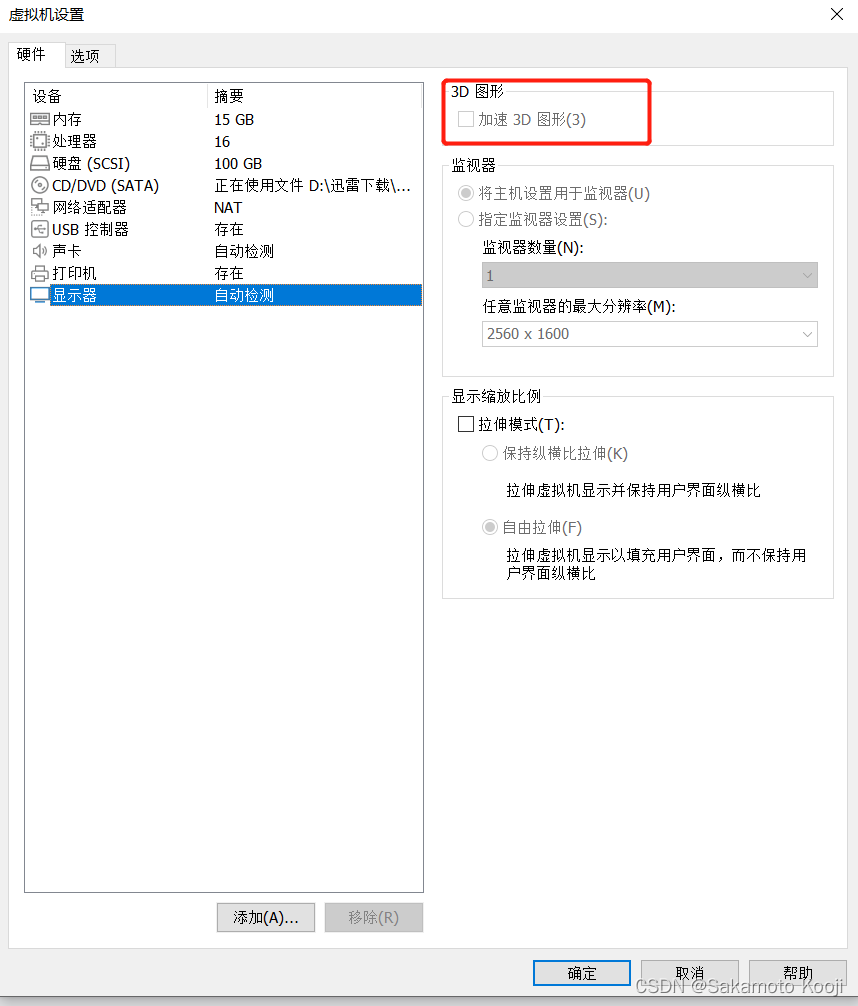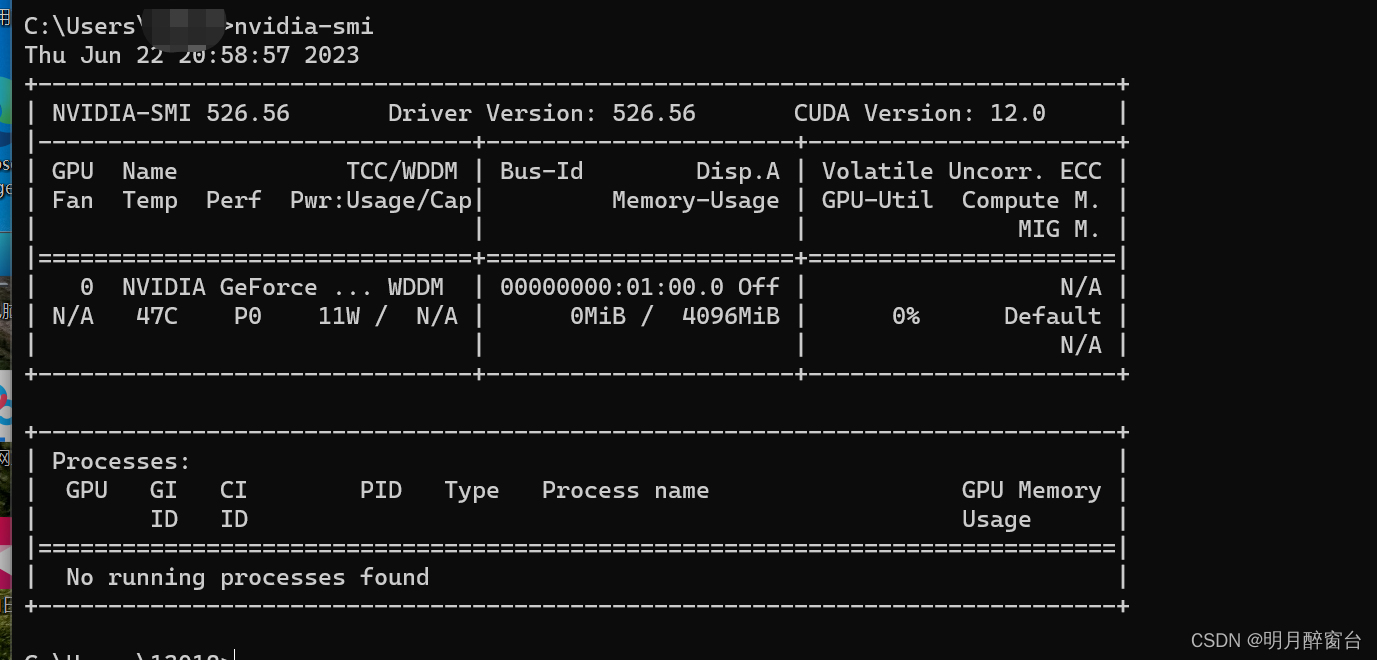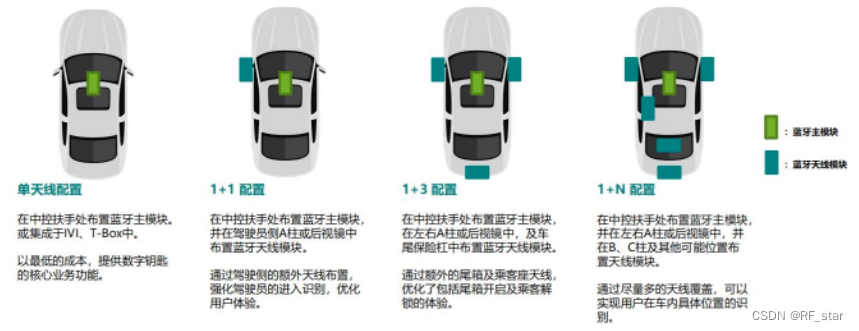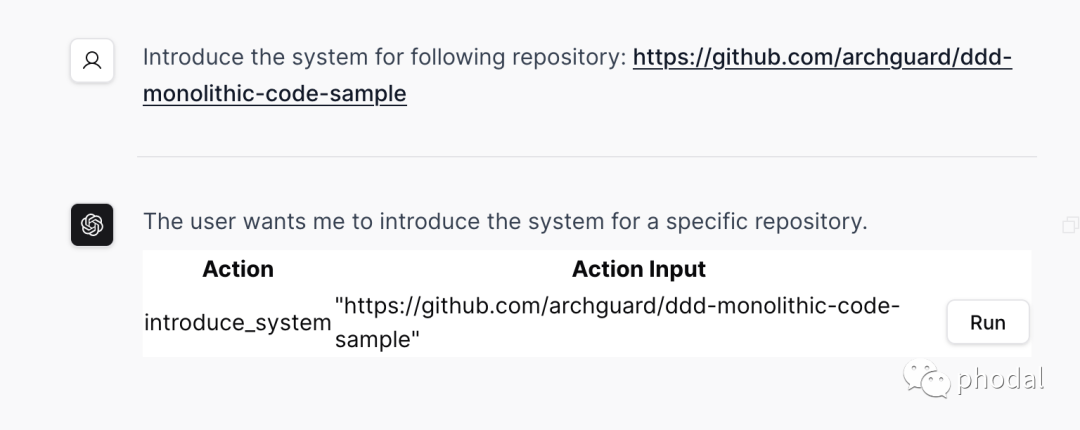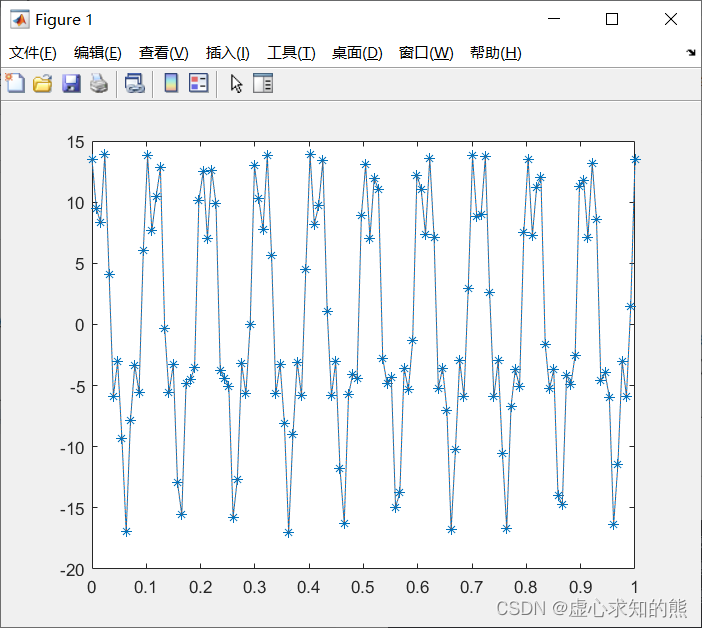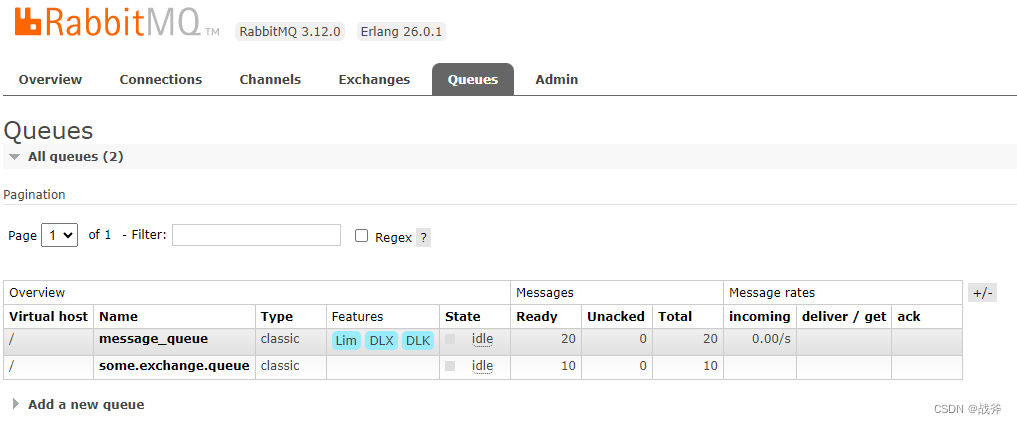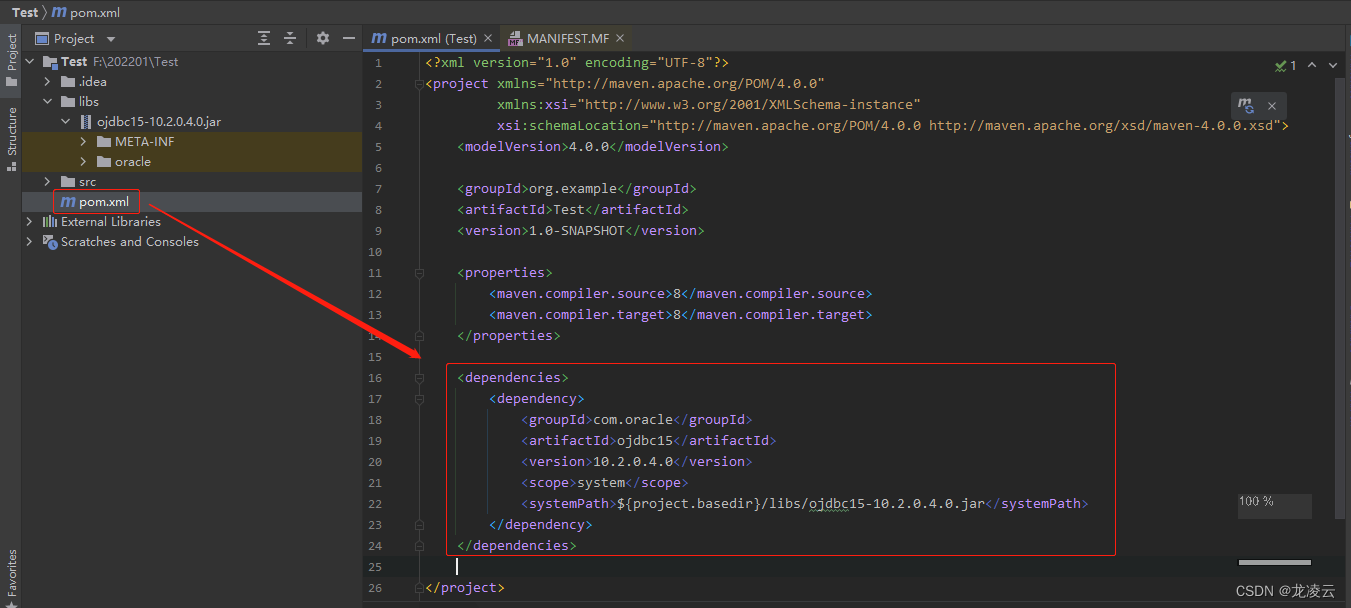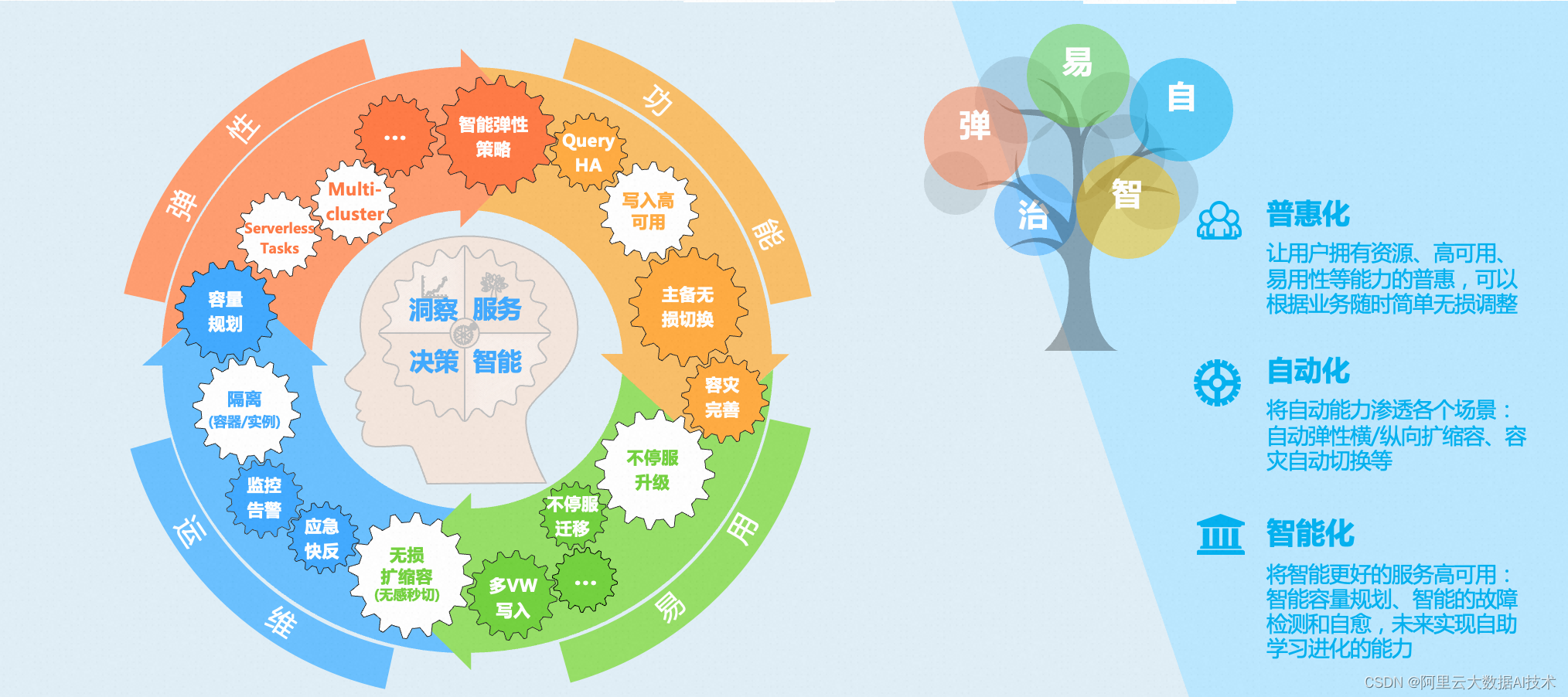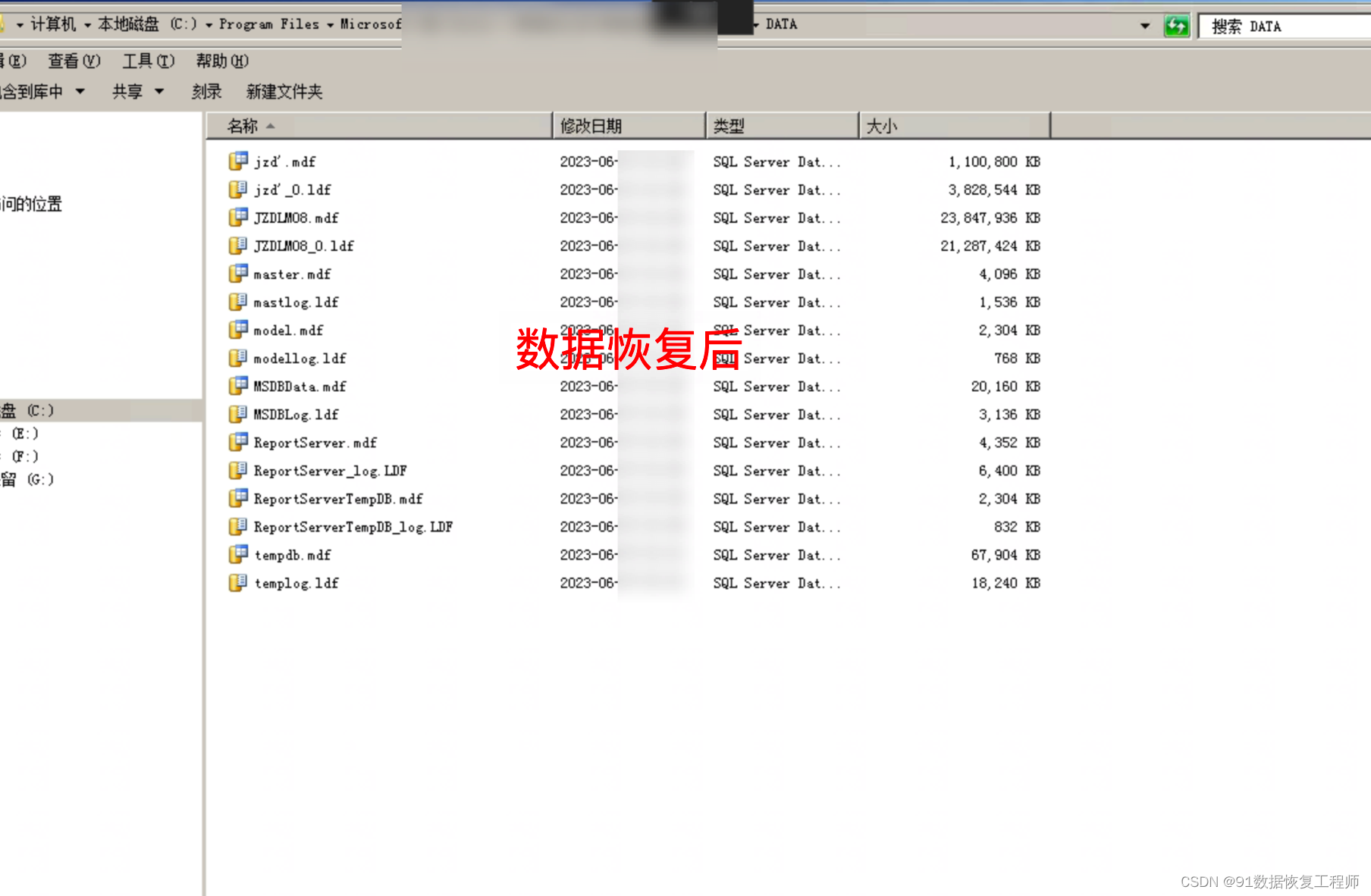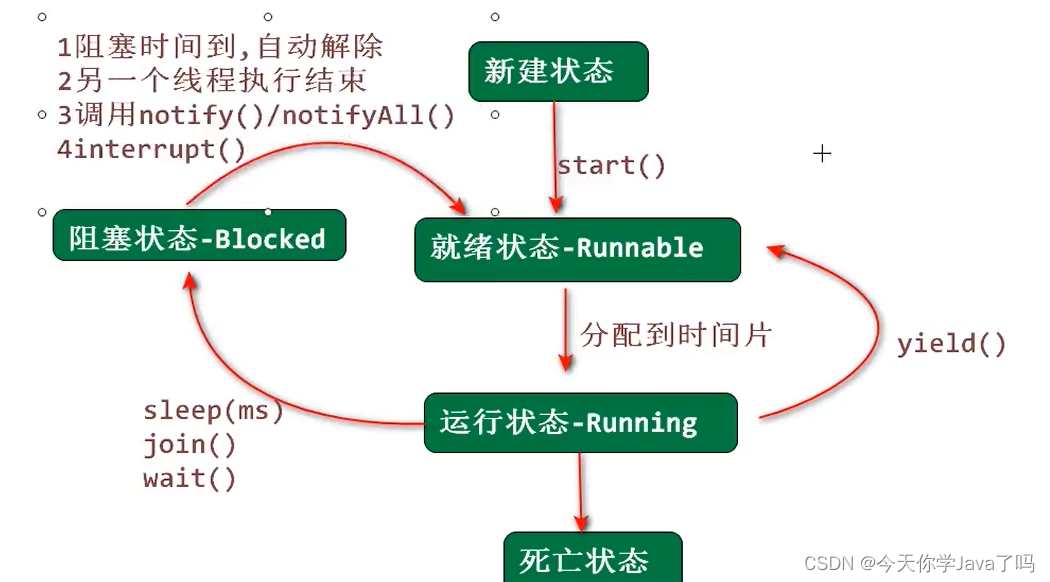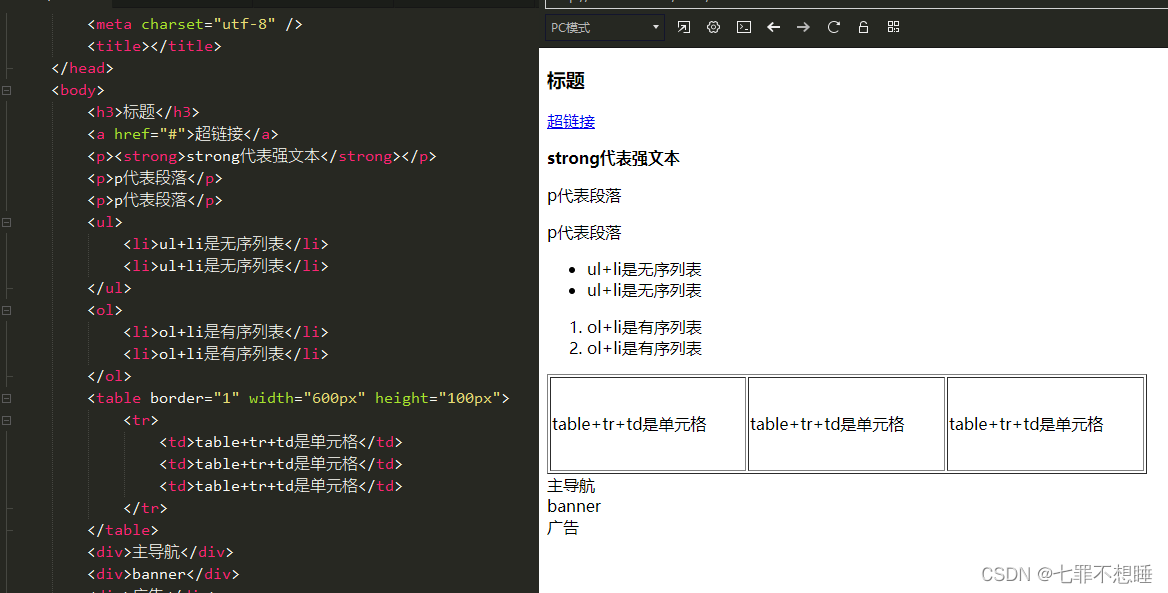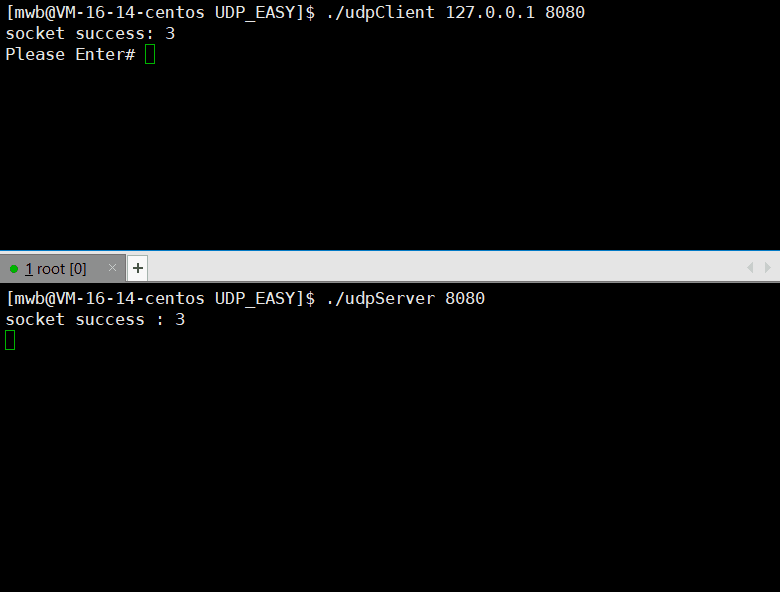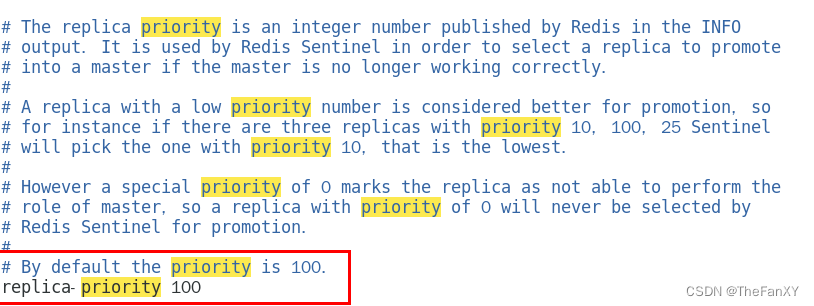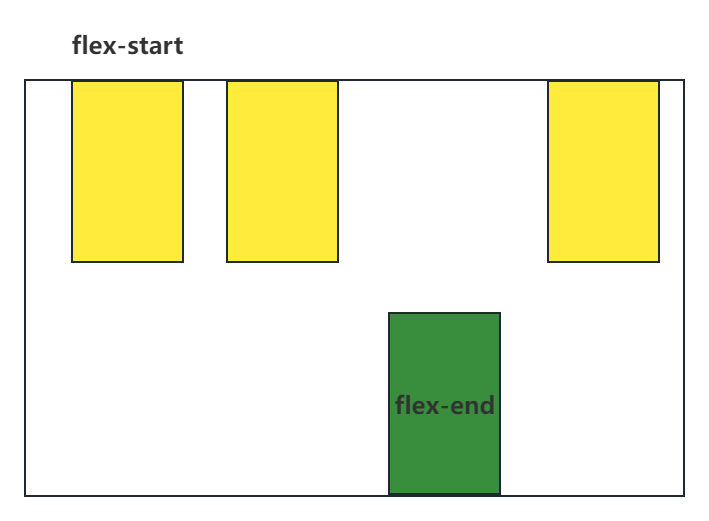Spring源码系列整体栏目
| 内容 | 链接地址 |
|---|---|
| 【一】spring源码整体概述 | https://blog.csdn.net/zhenghuishengq/article/details/130940885 |
| 【二】通过refresh方法剖析IOC的整体流程 | https://blog.csdn.net/zhenghuishengq/article/details/131003428 |
| 【三】xml配置文件启动spring时refresh的前置工作 | https://blog.csdn.net/zhenghuishengq/article/details/131066637 |
| 【四】注解方式启动spring时refresh的前置工作 | https://blog.csdn.net/zhenghuishengq/article/details/131113249 |
spring底层源码整体概述
- 一,xml配置文件启动spring时refresh的前置工作
- 1,super(parent)
- 2,setConfigLocations()
- 2.1,获取系统属性和系统环境
- 2.2,解析系统环境和系统属性
- 3,总结
一,xml配置文件启动spring时refresh的前置工作
前两篇大概的描述了一下springIoc的整体流程,接下来再对里面的细节进行分析。如下依旧是通过经典的xml的方式获取到上下文,并且在resources目录下配置一个spring.xml文件,这里推荐使用debug的方式,从上往下看
ApplicationContext ioc=new ClassPathXmlApplicationContext("classpath:spring.xml");
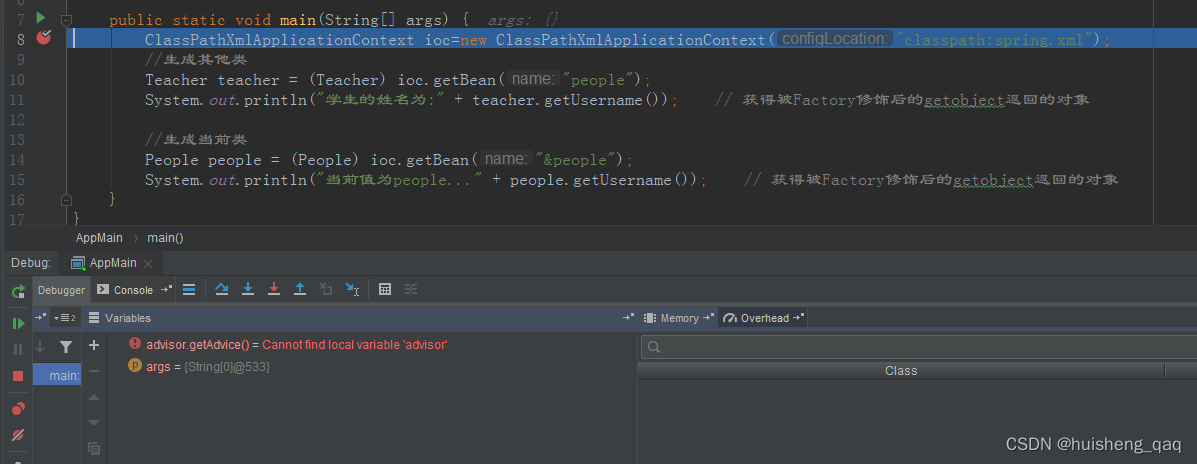
进入这个获取上下文的构造方法之后,可以发现有调用了这个this方法
public ClassPathXmlApplicationContext(String configLocation) throws BeansException {
this(new String[] {configLocation}, true, null);
}
接下来在进入这个this方法,就是一个熟悉的方法,该方法在前两篇中有所提到。接下来重点就是对里面的前两个方法进行深究,弄清refresh的前置工作到底做了什么
public ClassPathXmlApplicationContext(
String[] configLocations, boolean refresh, @Nullable ApplicationContext parent)
throws BeansException {
super(parent); // 初始化父类 ,获得xml路径资源解析器
setConfigLocations(configLocations); // 通过环境变量解析 xml路径
if (refresh) {
refresh(); // 这个方法时spring是最终要的一个方法,甚至体系整个ioc的声明周期
}
}
1,super(parent)
在该方法中,第一步就是初始化父类,后面很多需要使用的对象,就是在这一步被创建的,而里面的super继续调用自己的super,直到创建一个资源模式处理器,该 AbstractApplicationContext 相对来说比较重要,并且那个最重要的refresh 方法就是在这个抽象类里面
public AbstractApplicationContext() {
//获取资源模式处理器
this.resourcePatternResolver = getResourcePatternResolver();
}
接下来就是查看这个具体的获取资源处理器的流程,里面的xml文件,或者其他的注解配置文件,都是能获取的资源,获取到资源之后就对资源进行一个解析操作
protected ResourcePatternResolver getResourcePatternResolver() {
return new PathMatchingResourcePatternResolver(this);
}
接下来在查看这个 PathMatchingResourcePatternResolver 对象,可以发现里面就是获取资源对象加载器。并且里面还存在一个对象PathMatcher,用做于路径匹配
//用于模式匹配,默认使用的是 PathMatcher
private PathMatcher pathMatcher = new AntPathMatcher();
//获取资源加载器
public PathMatchingResourcePatternResolver(ResourceLoader resourceLoader) {
Assert.notNull(resourceLoader, "ResourceLoader must not be null");
this.resourceLoader = resourceLoader;
}
在这个ResourceLoader 类中,主要就是两个方法,一个是用于加载资源,一个是用于加载类加载器
//加载资源
Resource getResource(String location);
@Nullable
//加载类加载器
ClassLoader getClassLoader();
在这个 AbstractApplicationContext 构造方法中,完成this获取一个资源解析器之后,接下来就是一个设置一个Parent的父类,当前springIOC中是没有父子容器的概念的,因此到后续的springMVC再进行分析
public AbstractApplicationContext(@Nullable ApplicationContext parent) {
this();
//springIOC中暂时没有父子容器概念,先跳过
setParent(parent);
}
因此这一整个步骤,都是为了初始化成员变量。而最主要的,就是初始化一个资源的解析器。
2,setConfigLocations()
在获取到这个资源解析器之后,接下来就是设置文件的路径。如在正常开发的springboot项目中,通过设置环境的的属性来表名是dev环境还是线上环境等。这个locations参数就是 new String[] {configLocation}
//参数可以是对象或者数组
public void setConfigLocations(@Nullable String... locations) {
if (locations != null) {
Assert.noNullElements(locations, "Config locations must not be null");
this.configLocations = new String[locations.length];
for (int i = 0; i < locations.length; i++) {
this.configLocations[i] = resolvePath(locations[i]).trim();
}
}
else {
this.configLocations = null;
}
}
2.1,获取系统属性和系统环境
在获取到外部传进来的文件路径之后,接下来会通过这个 resolvePath方法解析这个路径。而在解析这个路径时,需要通过系统环境变量来解析,如果环境变量为空,则创建一个标准的环境变量
protected String resolvePath(String path) {
//获取环境
return getEnvironment().resolveRequiredPlaceholders(path);
}
//如果获取的环境为空,则创建一个标准环境
protected ConfigurableEnvironment createEnvironment() {
return new StandardEnvironment();
}
而在这些环境中,存在一些spring环境变量的类型,分别是可忽视的,活跃的默认的等
public static final String IGNORE_GETENV_PROPERTY_NAME = "spring.getenv.ignore";
public static final String ACTIVE_PROFILES_PROPERTY_NAME = "spring.profiles.active";
public static final String DEFAULT_PROFILES_PROPERTY_NAME = "spring.profiles.default";
protected static final String RESERVED_DEFAULT_PROFILE_NAME = "default";
同时在这个标准环境中,主要分为系统环境和系统属性等
![[外链图片转存失败,源站可能有防盗链机制,建议将图片保存下来直接上传(img-Vp1Jnj13-1686031945306)(img/1686014233433.png)]](https://img-blog.csdnimg.cn/4e6d051ee29f4c5da8d3cce41ef259af.png)
//系统环境属性资源名称
static final String SYSTEM_ENVIRONMENT_PROPERTY_SOURCE_NAME = "systemEnvironment";
//系统配置变量资源名称
static final String SYSTEM_PROPERTIES_PROPERTY_SOURCE_NAME = "systemProperties";
最后将全部的系统环境和系统属性一起加入到 propertySources 这个PropertySources集合中,该集合是在父类中实例化的,因此会作为一个全局共享的资源,其子类都能获取和访问
protected void customizePropertySources(MutablePropertySources propertySources) {
propertySources.addLast(
new PropertiesPropertySource(SYSTEM_PROPERTIES_PROPERTY_SOURCE_NAME, getSystemProperties()));
propertySources.addLast(
new SystemEnvironmentPropertySource(SYSTEM_ENVIRONMENT_PROPERTY_SOURCE_NAME, getSystemEnvironment()));
}
加入到集合的value值主要是系统的变量和系统的环境。
//获取系统的属性值
getSystemProperties(){System.getProperties()};
//获取系统的变量
getSystemEnvironment(){System.getenv()};
在创建这个 StandardEnvironment() 标准的环境的时候,可以在父类的无参构造方法中打一个断点,可以发现此时会有两个属性值,就是上面的系统属性值和系统环境值
![[外链图片转存失败,源站可能有防盗链机制,建议将图片保存下来直接上传(img-AhwsdtvS-1686031945307)(img/1685946585512.png)]](https://img-blog.csdnimg.cn/b1cd7e9a55674143ac15eab0b7620008.png)
而在下面的propertySourceList的第一个值systemProperties中,已经加载了56个系统属性,比如说一些 jdk的版本,虚拟机的版本,操作系统的名称,当前用户的名称等等
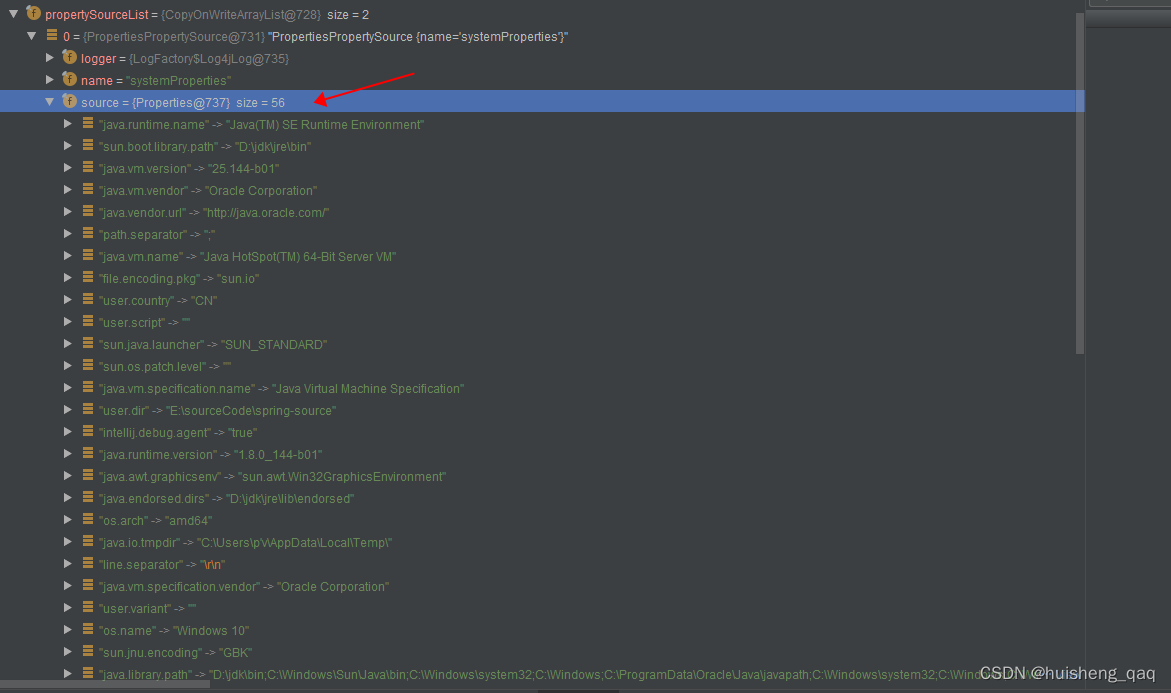
在下面的propertySourceList的第二个值systemEnvironment中,也有49个值,比如说当前电脑的名称,使用的maven路径以及版本,java_home的路径,用户的用户名等等
![[外链图片转存失败,源站可能有防盗链机制,建议将图片保存下来直接上传(img-JUlyXlED-1686031945308)(img/1685947066781.png)]](https://img-blog.csdnimg.cn/e36621c44f74406e91d9bd932aa49628.png)
此时这些默认的环境对象和环境变量就全被获取。当然这些环境变量的数量也可能因为源码的版本不同个数也会不同。
2.2,解析系统环境和系统属性
又回到上面的第二步,此时环境变量值依旧获取,因此接下来就继续执行这个 resolveRequiredPlaceholders 方法
protected String resolvePath(String path) {
//获取环境
return getEnvironment().resolveRequiredPlaceholders(path);
}
在resolveRequiredPlaceholders方法中,会获取到刚刚全部获取到的环境和属性,然后对这些环境和属性做一个解析操作。这里的话类似于一个责任链模式,系统环境要处理的会有对应的方法处理系统环境,系统属性要处理的会有对应的方法处理系统属性。下面这个是处理系统环境的方法
@Override
public String resolveRequiredPlaceholders(String text) throws IllegalArgumentException {
//this.propertyResolver:全部的系统环境和系统属性
return this.propertyResolver.resolveRequiredPlaceholders(text);
}
处理完系统环境之后,会再次通过这个责任链模式,去处理对应的系统属性,下面这个是处理系统属性的方法
@Override
public String resolveRequiredPlaceholders(String text) throws IllegalArgumentException {
if (this.strictHelper == null) {
this.strictHelper = createPlaceholderHelper(false);
}
//解析工作
return doResolvePlaceholders(text, this.strictHelper);
}
而在处理系统属性时,会有一个 createPlaceholderHelper 方法,类似于一个builder的工厂类
private PropertyPlaceholderHelper createPlaceholderHelper(boolean ignoreUnresolvablePlaceholders) {
//前缀,后缀
return new PropertyPlaceholderHelper(this.placeholderPrefix, this.placeholderSuffix,
this.valueSeparator, ignoreUnresolvablePlaceholders);
}
在获取到这个strictHelper 对象之后,接下来开始真正的进行解析工作
private String doResolvePlaceholders(String text, PropertyPlaceholderHelper helper) {
return helper.replacePlaceholders(text, this::getPropertyAsRawString);
}
再次进入这个replacePlaceholders 这个方法,可以发现里面会有一个重要的方法parseStringValue
public String replacePlaceholders(String value, PlaceholderResolver placeholderResolver) {
Assert.notNull(value, "'value' must not be null");
return parseStringValue(value, placeholderResolver, new HashSet < > ());
}
接下来查看这个 parseStringValue 方法,首先会判断当前的value值中是否包含一个 $ 的大括号,并且会递归的判断是否存在$ 的嵌套,判断完成之后,会对里面的值进行解析。
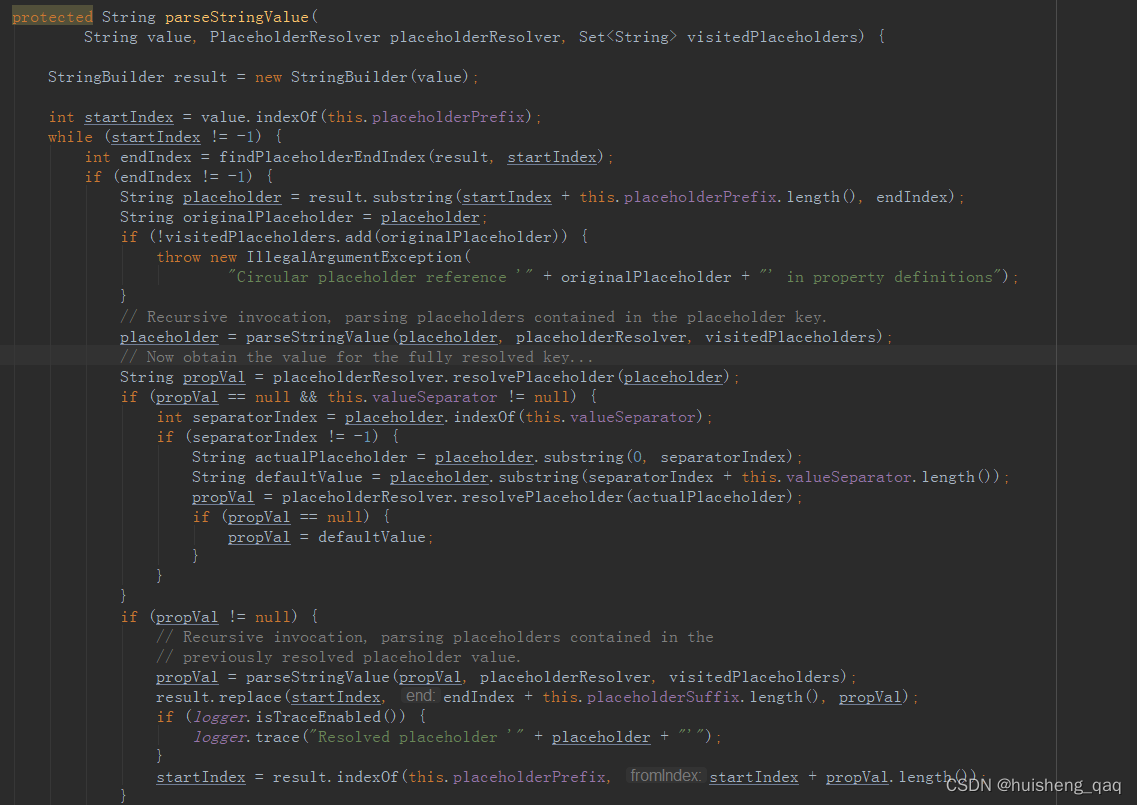
在获取完这个 符之后,接着就是递归的循环遍历资源中的 k e y 值,将 < c o d e > 符之后,接着就是递归的循环遍历资源中的key值,将<code> 符之后,接着就是递归的循环遍历资源中的key值,将<code>{USERNAME} 对应的值进行一个替换操作。
String propVal = placeholderResolver.resolvePlaceholder(placeholder);
再次跟着debug断点走,可以发现会进入 PropertySourcesPropertyResolver 类的 getProperty 方法里面
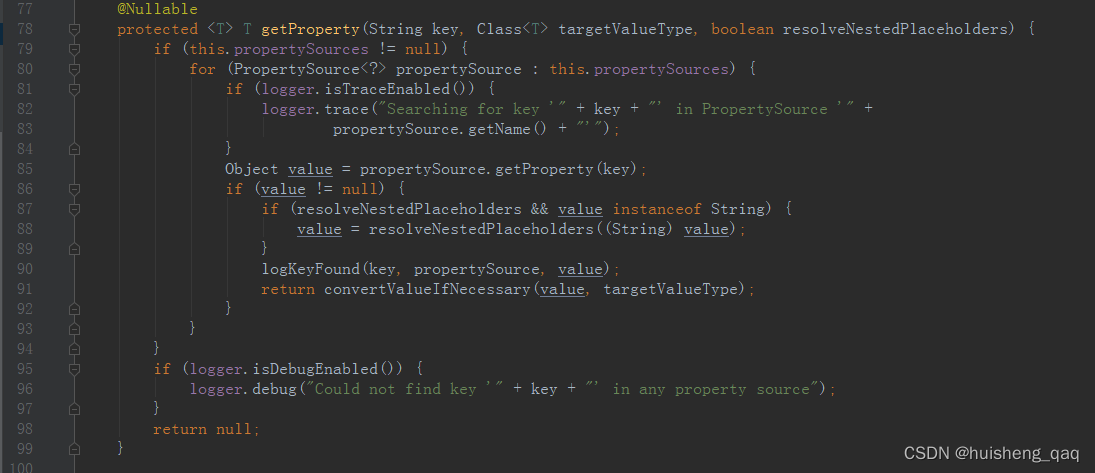
里面进行循环的取值,将${}里面的值和系统属性或者系统变量的值进行匹配,如果匹配成功,则进行替换的操作
@Nullable
protected < T > T getProperty(String key, Class < T > targetValueType, boolean resolveNestedPlaceholders) {
if (this.propertySources != null) {
for (PropertySource << ? > propertySource : this.propertySources) {
//取值
Object value = propertySource.getProperty(key);
if (value != null) {
//取值成功,则进行替换操作
if (resolveNestedPlaceholders && value instanceof String) {
value = resolveNestedPlaceholders((String) value);
}
logKeyFound(key, propertySource, value);
//如果需要的换则进行值转换
return convertValueIfNecessary(value, targetValueType);
}
}
}
return null;
}
接下来再进入转换的convertValueIfNecessary 方法,如果不需要转换则直接返回,需要转换则转换
@Nullable
protected < T > T convertValueIfNecessary(Object value, @Nullable Class < T > targetType) {
if (targetType == null) {
return (T) value;
}
ConversionService conversionServiceToUse = this.conversionService;
if (conversionServiceToUse == null) {
if (ClassUtils.isAssignableValue(targetType, value)) {
return (T) value;
}
conversionServiceToUse = DefaultConversionService.getSharedInstance();
}
//转换
return conversionServiceToUse.convert(value, targetType);
}
如已知刚刚获取到的系统环境变量中存在一个 USERNAME=‘PV’,那么假设xml的文件名为 spring-$ {USERNAME}.xml ,那么结果这个解析器进行解析之后,就会将这个${}里面的值进行一个替换操作,会将这个文件名变成 spring-PV.xml 文件。如果存在$的嵌套,那么就会递归的进行一个判断和替换操作, 最终会将解析后的文件返回。
自此为止,属性值就全部加载和解析完成。此时所有的配置文件路径等,都添加在重要的类AbstractRefreshableConfigApplicationContext的configLocations 的属性里面。
private String[] configLocations;
除了刚刚举例,还有像一些jdbc的连接参数等等,其原理都是一样的,都是通过这种方式替换
"${jdbc.url}")
"${jdbc.driverClassName}"
"${jdbc.username}"
"${jdbc.password}"
3,总结
也就是通过这个xml的方式作为配置文件,在调用refresh方法之前,主要就是做了两件事情:首先是初始化一个资源的解析器,随后是获取系统的属性和系统的环境变量,同时对配置文件的路径进行解析。至此为止,refresh需要准备的前戏工作结束。
![[RocketMQ] Consumer消费者启动主要流程源码 (六)](https://img-blog.csdnimg.cn/70d00419aa744d6a8f7bfe8c684a47d7.png)


